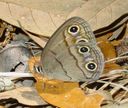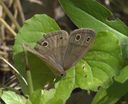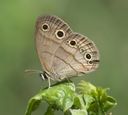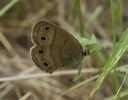Hodges#4578
Megisto cymela
Classification
- Phylum: Arthropoda
- Subphylum: Hexapoda
- Class: Insecta
- Order: Lepidoptera
- Superfamily: Papilionoidea
- Family: Nymphalidae
- Subfamily: Satyrinae
- Tribe: Satyrini
- Genus: Megisto
- Species: cymela
Pronunciation
How to pronounce Megisto cymela: /mɛˈɡɪstoʊ saɪˈmɛlə/
These audio files are automatically generated. While they are not always 100% accurate, they are a good starting point.
Images






Summary
Megisto cymela, commonly known as the Little Wood Satyr, is a butterfly species of the Satyrinae family found primarily in North America, characterized by its distinctive eyespots and unique habitat preferences.
Physical Characteristics
Adult wingspan is 29-48 mm; Upperside features yellow-rimmed black eyespots on each wing, with large dark eyespots on the hindwing underside. Larval body is light greenish-brown with a dark dorsal stripe and alternating brown and yellowish lateral stripes, covered in small bumps with reddish-brown hairs; head is dirty white, tails are light gray.
Identification Tips
Forewing has at least two large spots larger than others; hindwing contains two large dark eyespots and several smaller spots on the underside. Differentiated from Carolina Satyr and Red Satyr by presence of multiple large eyespots and coloration.
Habitat
Prefers open habitats with deciduous trees, marshy areas, and brushy cover. Often found in forests, along edges, brush-filled openings, and grassy areas between forested patches.
Distribution
Occurs in the eastern United States and southeastern Canada, from Nova Scotia to Florida, and west to Texas, Saskatchewan and Wyoming.
Diet
Larvae primarily feed on grasses including Orchardgrass (Dactylis glomerata), Kentucky Bluegrass (Poa pratensis), and Centipede Grass (Eremochloa ophiuroides). Adults feed on plant sap, aphid honeydew, and occasionally nectar.
Life Cycle
Adults in northern regions fly between June and July; in southern regions, they fly from March to September. One generation per year in Canada; two or three farther south.
Reproduction
Females lay eggs singly on grass blades; the caterpillars overwinter as fourth-instar larvae.
Similar Taxa
Tags
- butterfly
- Nymphalidae
- North America
- habitat
- diet